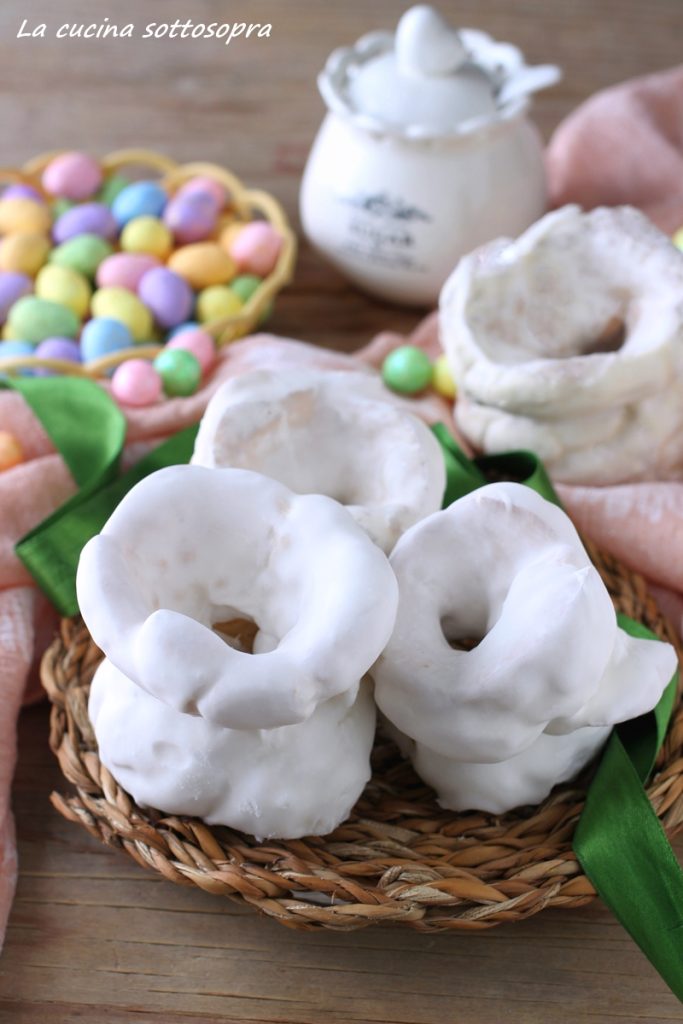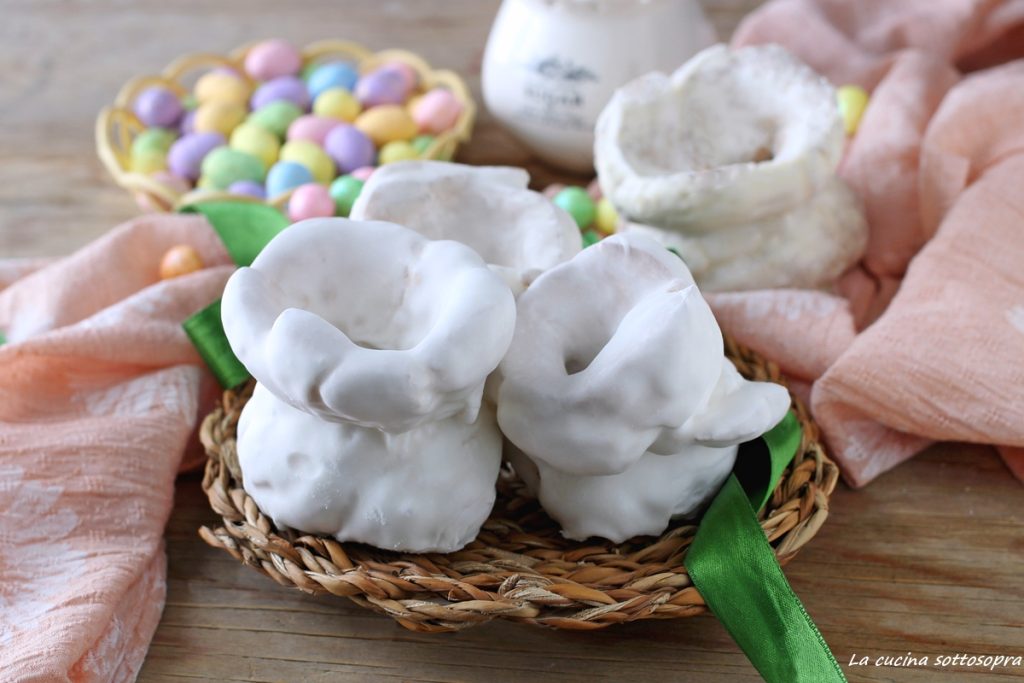Apulian Easter taralli with glaze are ancient, traditional sweets made during Easter, alongside the inevitable scarcella and Easter egg pastries. These Easter taralli differ in size and texture from the classic ‘savory’ tarallini: they are quite large, have a substantial longitudinal cut characteristic of them, and are often coated with glaze, known as ‘gileppo’ or ‘scileppo’. However, in many areas of Apulia (including my hometown in the Northern Bari area), this custom is not very widespread, and they are often eaten plain with their slightly sweet and almost neutral taste. The glaze or gileppo serves a dual purpose: it adds sweetness and helps preserve them longer.
Back in our grandmothers’ days, making Easter taralli in large quantities during Lent, taking them to bakeries for baking, and having them blessed by a priest was common. The latter tradition has faded over time, but the practice of making taralli and other Easter sweets in large quantities is still alive and well!
Being a traditional recipe, every region of Apulia (and even parts of Southern Italy) and every family has its own traditional recipe. Still, they all undoubtedly share the use of simple and genuine ingredients: flour, sugar, oil, wine or grappa, and little else.
Making sweet Easter taralli with ‘scilepp’ or gileppo isn’t very difficult, but I recommend starting to prepare them in advance, as they require a double baking and, importantly, a full night’s rest between bakes. Ideally, start in the afternoon and finish baking the next morning.
Alright, let’s see the recipe and how to make Apulian Easter taralli with glaze.

- Difficulty: Medium
- Cost: Economical
- Rest time: 12 Hours
- Preparation time: 2 Hours
- Portions: 12
- Cooking methods: Electric oven
- Cuisine: Italian Regional
- Seasonality: Easter
- Energy 380.51 (Kcal)
- Carbohydrates 77.97 (g) of which sugars 51.10 (g)
- Proteins 6.62 (g)
- Fat 5.66 (g) of which saturated 1.27 (g)of which unsaturated 0.92 (g)
- Fibers 0.85 (g)
- Sodium 82.89 (mg)
Indicative values for a portion of 100 g processed in an automated way starting from the nutritional information available on the CREA* and FoodData Central** databases. It is not food and / or nutritional advice.
* CREATES Food and Nutrition Research Center: https://www.crea.gov.it/alimenti-e-nutrizione https://www.alimentinutrizione.it ** U.S. Department of Agriculture, Agricultural Research Service. FoodData Central, 2019. https://fdc.nal.usda.gov
Ingredients for making Apulian Easter taralli with glaze
- 4 cups all-purpose flour (or cake flour)
- 5 eggs (medium)
- 3/4 cup sugar (for a sweeter taste, use up to 1 to 1 1/4 cups)
- 1/4 cup extra virgin olive oil
- 1/8 cup grappa (or white wine)
- 1 pinch salt
- 3 g baking ammonia
- 2 1/2 cups granulated sugar
- 7/8 cup water
- A few drops lemon juice
Tools for making Apulian Easter taralli with glaze
- Stand Mixer
- Work Surface
- Knives
- Tea Towel
- Pot
- Parchment Paper
- Baking Sheet
- Oven
Steps for making Apulian Easter taralli with glaze
Let’s see how to make these glazed sweet Apulian taralli, typical of the Easter tradition in Apulia.
In the bowl of the stand mixer, place the eggs with a pinch of salt and start the paddle attachment at medium speed.
With the paddle moving, add the oil and the grappa (or alternatively, white wine).
Gradually add the flour, sugar, and baking ammonia. Knead for 5-10 minutes. Once the dough is somewhat formed, you can switch the paddle attachment to the dough hook and continue kneading until it is well incorporated (meaning it starts to stick to the hook and detach from the sides of the mixer bowl).
Continue kneading the dough by hand on a lightly floured surface, and when it’s firm and homogeneous, let it rest for about half an hour covered with a clean tea towel.
After the rest time, take the dough and cut it into 12-13 similarly sized pieces. Work it a bit with your hands until you create small balls.
To shape the taralli, you can proceed in two ways: either create a sausage shape and then join the ends well, or slightly flatten the balls and use your fingers to make a hole in the center, creating a small donut.
Cover the taralli with a tea towel and move on to the boiling phase.
Place a large pot filled with water on the heat. Heat it (do not let it boil, it should reach about 176°F!) and just before it boils, place 2 or 3 taralli in the pot, wait until they float to the surface, then remove them with a slotted spoon and place them on a dry tea towel. Continue until all the taralli are used up.
Once lukewarm, use a knife to make a long cut along the tarallo without going too deep. This way, the taralli will open during baking and take on their characteristic shape.
At this point, cover them with a second tea towel and let them rest for at least 12 hours (a whole night).
After this rest period, prepare a baking sheet with a parchment paper and arrange the taralli well-spaced from each other.
Preheat the oven to the maximum (about 446°F) and bake. After the first 10 minutes, lower the oven temperature to 392°F, and after another 10 minutes, lower it again to 356°F and continue baking for another 10 minutes. The total baking time should be about 30 minutes.
Turn off the oven and let the taralli cool with the door slightly open.
To make the gileppo or scileppo, put the sugar and water in a pot. Bring the syrup to a boil. The glaze is ready when, placed between your thumb and index finger (be careful not to burn yourself!), the sugar begins to thread.
Glazing must be very fast before the sugar solidifies again.
Dip the taralli in the glaze and then place them on a wire rack to cool. If you want a whiter glaze, you can repeat the process multiple times to achieve the desired effect. Keep in mind, however, that once cold, the glaze becomes hard, and therefore the consistency of the tarallo itself will become crunchier.

Notes
– Apulian Easter taralli with glaze are best stored in a tightly sealed container. They maintain their crunchiness for 1-2 weeks.
– If you don’t like the glaze, you can omit it and enjoy them plain: in this case, I recommend increasing the sugar in the dough to 1 1/4 cups.
– Glazed Easter taralli are also great for breakfast or dipped in sweet or liqueur wines like Vin Santo.

